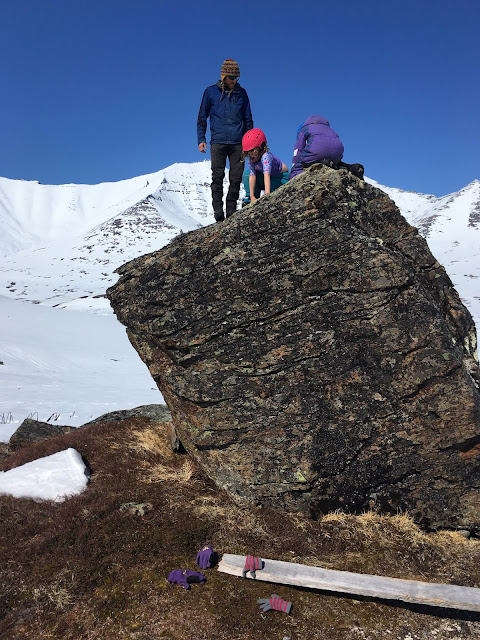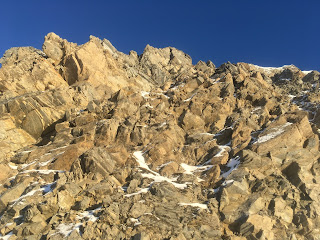 |
| Nick Treinen on Pk. 1781, Moon Mountains, Seward Peninsula |
Zooming back from the Moon Mountains down the Norton Sound coast on my spanking new SkiDoo Expedition Ace on the weekend following our conquest of Peak Grand Union, I felt confident in my new sled, the first example of a modern-style 4-stroke push-button machine I have ever ridden. Until, that is, I slammed head-on into the shimmering, invisible, outer envelope of a "phase-variation vortex" that lay in wait out there by the Cripple River mouth, sort of like an electromagnetic, tidal rip, causing my new machine to malfunction immediately, stop dead in its tracks, and stop working altogether.
I was perturbed; you don't expect this kind of behavior from a brand new machine. The thing started again, it stopped again, it was confused, then stopped for good. In the old days, I raised the hood and might well have been able to fix the problem, but with the new push-button machines, all I could really do was contemplate my button. Not until many months later would I finally discover the truth about the malfunction. Read this post until the end, because you won't find about this potential product hazard anywhere else but kigsblog.
 |
| Telly the Moons |
The gimmick was to find a viable approach to the fabled Moon Mountains. You hear a lot about the Moons because their name conjures shades of Edgar Allen Poe and Lunar Modules, but in fact, they're called the Moon Mountains mostly because of weird-looking tundra, or the lack thereof, basically an eroded pile of magic minerals where not much grows. However, the actual magic of the area comes not from the lunar color of the landscape but the geo-electromagnetic bends and folds that ebb and flow around this region of coast, which makes the Moon Mountains worthy of Poe after all, a spooky place. My Numinosity Scale Ratings showed the PHI to be out of control at certain moments, which I am now positive had something to do with the mysterious demise of my snow-machine.
 |
| Looking South |
How to access the Moon Mountains was Nick's gimmick, one he eventually cracked the following summer by packrafting to the Moon Mountains down the Sinuk River from the Teller Road bridge, and then walking the coastline back to Nome!
"Zer are no mountains zer vort climbink," (Anderl in The Eiger Sanction), but it seemed like easy pickings in the big snow year of 2018 to just blast into the Moons on snow-machine, scratch the Moon Mountain itch that everybody seems to get, ski around for a day, attain the high point, and fill out some NRE's (Numinosity Rating Estimate) to get an overall assessment of the PHI levels in the region.
 |
Norton Sound coast between Nome and Woolley Lagoon. The Moon Mountains is the
gray patch towards the left. Looking at about thirty miles of coastline here.
|
Criteria for Sentience of Landscape
For a defined region of the Earth's surface, sentience may be supported by the presence of one or more of the following phenomena.
1. Geological discontinuity: a rift, upheaval, clash, or upwelling within the Earth's crust
2. A rich human or animal history: artifacts, ancient crossroads of culture
3. Electromagnetic flux: mineral-caused, position or variation in the Earth's magnetosphere
4. A distinct landform: prominence, uniformity, analogue, definition of structure, nonentropy
PHI resonance is a by-product of these phenomena so is not included on the list of causes. PHI is also a system of measurement. PHI bears a relation to sentience as something like voltage does to electricity: unit of measurement to elemental force.
Elevated PHI-resonance levels will usually be scaled when the phenomena mentioned in these criteria.
 |
| "Over the Mountains of the Moon, / Down the Valley of the Shadow... |
My own gimmick was the usual one, fabricated, as usual when there are is no real climbing to be had: the High-pointing Conceit. The plan was to conquer, nay, subdue the Moon Mountains by climbing to the highest elevation point. Nick agreed to this reductionist goal— but at least high-pointing provides a white man structure in a wilderness of choices. The Moon Mountains do not qualify as mountains, but as hills, and Pk. 1781 was not slated to be Piolet d'Or material.. We could easily have driven snow-machines to the top, but it is necessary to kill the engines in order to conduct geopsychic research, so we skied around on the excellent 2018 snow cover, and skied to the top of the Moons' high-point. Our PHIDs crackled with activity, but absent of the near-death experience associated with real, death-defying climbing, little of which exists in the central Moons, I was unable to achieve triangulation off the death attractor, and my Numinosity Scales went flat, despite Nick and I having a once-in-a-lifetime, beautiful day in a sacred, charged, and powerful place.
 |
| Ride, boldly ride," the Shade replied, / "If you seek for Eldorado!" |
And what of the brand-new Expedition Ace? Well, I have a theory...
The section of Norton Sound Coast where the Moon Mountains meet the sea, located between the mouth of the holy Sinuk River and Woolley Lagoon, is a confusing section of coast. At least for me— when you live in Nome, you get used to thinking of the coast as a direct east-west line, but in fact, if you get about 15 miles down the beach west of Nome, the coast begins to imperceptibly curve to a northwest-southeast asymptote, but a Nomeite like me fails to notice, and still assumes they are heading due west. I mention this only because it relates to an understanding of what caused the CPU in my brand-new SkiDoo to suddenly malfunction.
Picture a map of the Seward Peninsula coastline overlaid not with weather data, but energy data, specifically, electromagnetic energy, but calibrated down to the level of atomic event horizons, (we are hunting for the patterns that will prove synchronicity somewhere in the rubix cube of leptons, hadrons, and quarks) calibrated with a time exponent that I don't think has quite been discovered yet but will be any day. What do you see? The overlay resembles auroral activity, which is plasmic energy. Remember, it's out of phase with our normal definition of time since it's occurring at the event horizon level. Also, just as land and water structures exert a considerable influence over the weather patterns of the region, so the land and water exerts an influence over this out-of-phase energy map we are viewing. Back to the subtle curvature of this section of the Norton Sound coast: it is this bending of the coast that makes it susceptible to tiny, almost infinitesimal rips in the fabric of the quantum foam that makes up our universe.
My snow-machine encountered one such geo-electromagnetic rip, as I was happily speeding along at excessive speeds heading home to Nome from the Moon Mountains that day. Muons, gluons, bosuns, gravitrons, God knows what other wave-particles, all started piling up somewhere in a very small dimension embedded within this dimension, a lot like a multiple-car pileup on the expressway at rush hour, causing a tiny variation in electromagnetic potential which was just barely enough to trip one of the micro-processors in the Central Processing Unit of the snow-machine existing in this physical universe, upsetting the programming in the CPU, some zeros getting changed to ones in the portion of its brain that handles automatic shutdowns, initiating weeks and weeks of frustrating malfunctions during which time my snow-machine was fated to leave me stranded multiple times, in several lonesome valleys, always promising full function at the beginning of the trip, and then growing confused and being unable to start once deep in the wilderness.
Fortunately, after Nick and I returned double-riding to Cripple River on a subsequent day, and limped, dragged, and cajoled the thing back to Nome, never quite fathoming the nature of the malfunction in this modern, pushbutton-type machine, the good folks at SkiDoo bought my story. They replaced the Ace's brain that had been damaged by excessive PHI in the Moon Mountains with another brain, on warranty.
Spoiledbysupercub's post about Moon Mountains in summer showing how they really look like the lunar surface














































